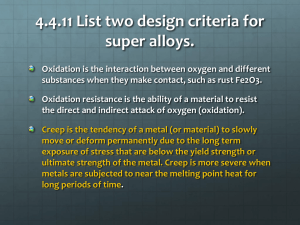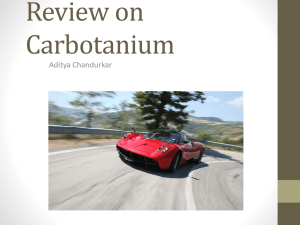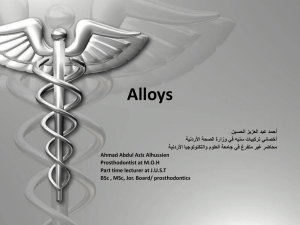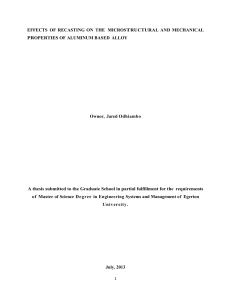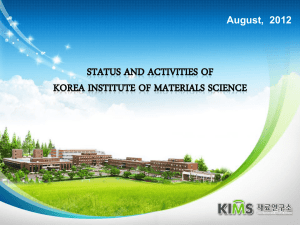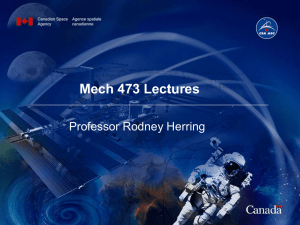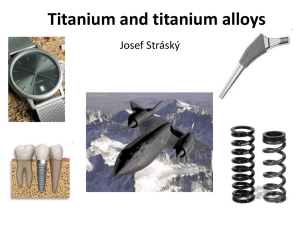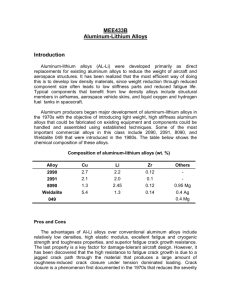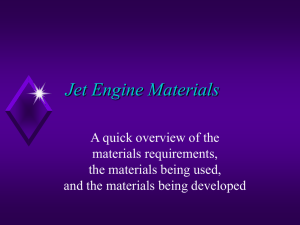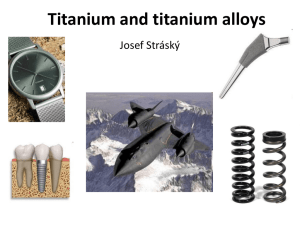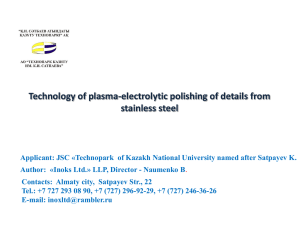Titanium and titanium alloys
advertisement
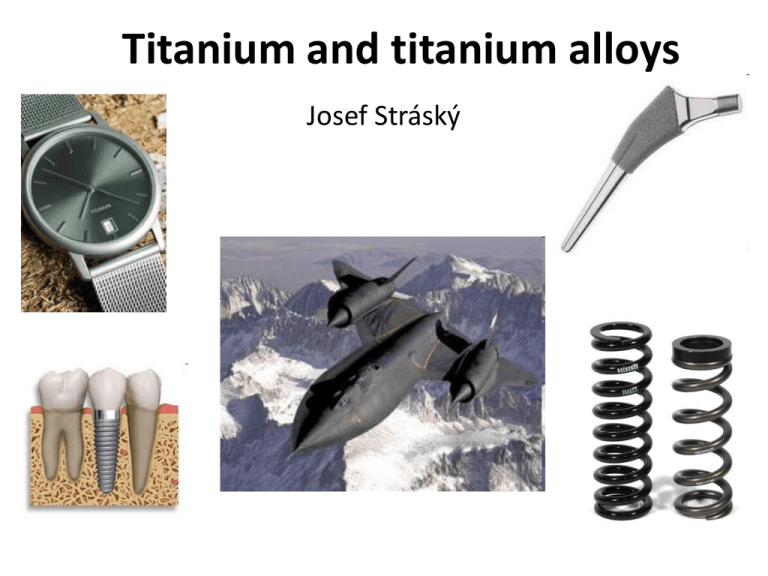
Titanium and titanium alloys Josef Stráský Lecture 4: Production technologies, experimental investigation, modern problems • Technology – • Experimental methods – – – – – • • • • Casting, forming Metalography Scanning and transmission electron microscopy X-ray diffraction Phase transformations investigation Mechanical properties and fatigue Titanium aluminides Shape memory effect Biocompatible alloys Ultra-fine grained Ti Casting • Liquid titanium is extremely reactive – • • • • • Casting must be done at vacuum of very clean inert atmosphere (He, Ar) Currently, there is no continuous process The bigger batch (size of primer ingot) the better economic efficiency typical ingot size: 10 – 15 tones Other option is electric arc melting (feasible only for research and development) Typical casting defects are segregation of either a or b stabilizing elements Homogenization treatment: 200 – 450°C above b-transus temperature; 20 – 30 hrs in industrial process; in laboratory usually 2-4 hrs Forming • • • • • • • Forging and rolling are commonly use to produce rods and sheets (sheets constitute 40% of production) First forming steps are done usually above b-transus temperature due to increased formability The temperature of future forming depends on thy particular alloy (and its type), formability and required properties The temperature control is essential due to undergoing phase transformations that may cause degradation of mechanical properties or even embrittlement during forming Precise time and temperature control allows wider use of metastable βTi alloys since material properties depend on ‘complete history‘ of material processing Hot working refer to forming above recrystallization temperature (usually it refers to forming above b-transus temperature) Cold working is forming below recrystallization temperature (well-bellow b-transus temperature, only rarely at room temperature) – Stress-relief treatment is required (sometimes interferes with phase transitions) Other technologies • Machining, cutting – Machining and cutting of Ti alloys is complicated, time demanding and costly – Ti alloys are extremely tough causing extreme heat generation and increased tool wear – Processes are costly due to low machining/cutting rate, cooling requirements and frequent tool replacements – Generated heat may also cause a) contamination, b) microstructural/phase transtion causing deterioration of mechanical properties • (Near)-net shape casting – Continuously increasing percentage of casted final products – Reduction of costly machining and welding • Powder metallurgy – Advanced technology for net-shape processing; small-scale production and chemical composition variability – However, industrial application is limited due to extreme titanium reactivity (requiring vacuum/inert atmosphere) – Continuous improvement in available technologies (e.g. field assisted sintering technique) • Superplastic forming – Ti alloys can be formed superplastically, but usually at high temperatures (>900°C) and using low strain rate (10-4 s-1), which significantly limits industrial use – Superplasticity depends on grain-size, therefore advances in grain size control (e.g. severe plastic deformation) can make superplastic forming feasible • Welding – The main issue is atmospheric contamination of welds that are extremely heated – Other issue are undergoing phase/microstructural transformations that significantly affect mechanical properties of the weld Experimental techniques – metallography (light microscopy) • Sample preparation – Standard grinding using series of grinding papers • • – Alumina is preferred to diamond pastes for polishing • • • – Abrasives of finer papers (starting from 800 mesh) tend to dig into the material This can be avoided by short etching by weak Kroll‘s etchant after each grinding/polishing step Polishing should be done down to 0.05 μm fineness Hydrogen peroxide and/or very weak solution of hydrofluoric acid can be added during polishing Grinding and polishing is generally much more complicated for β-Ti alloys (especially when in β solution treated condition) Etching • • Kroll‘s etchant is used to image different phases (i.e. α and β – typically to show microstructure of Ti6Al4V alloy) Oxalic acid shall be used to show grains (e.g. in pure Ti or solution treated β alloys) Light microscopy • Ti-35Nb-7Zr-5Ta and Ti-35Nb-7Zr-5Ta-1Si alloys – – • Biocompatible, low-modulus alloy Differential interference contrast (Nomarski contrast) Částice (Ti,Zr)5Si3 a relikty z broušení Scanning electron microscopy • The main requirement is flat, smooth and clean surface 1. Similar procedure to light microscopy might be used • Usually sufficient for Ti-6Al-4V, but not for b-alloys 2. Vibratory polishing • • • • • Excellent labor-saving polishing method Vibratory polisher is currently produced only by Buehler Three steps polishing: Alumina 0,3 mm, Alumina 0,05 mm and colloidal silica 8 hours (or more) each step Precise cleaning of samples and holders required between steps (or even short etching by diluted hydrofluoric acid) 3. Electrolytic polishing • • • Electrolyte: 5% H2SO4; 1,25% HF, in methanol Room temperature, 30 s Results are mixed, strongly depending on alloy Scanning electron microscopy • a + b alloy (Ti-6Al-4V) • Metastable b-alloy (Ti LCB) Scanning electron microscopy – Z-contrast • • a and b phase can be distinguished by back-scattered electrons thanks to different chemical composition (Z-contrast) b-phase contains more heavier elements it appears lighter SEM observations of Ti-6Al-7Nb alloy - Biomedical alternative to Ti-6Al-4V alloy - SEM image of duplex structure Z contrast dark – alpha interior – Al enriched, Nb depleted edge – equilibrium composition bright – beta - caused by double step annealing (970° + 750°C) 10 EBSD observations Ti-6Al-7Nb alloy • LEFT: EBSD image (orientation) image map) • RIGHT: grain boundaries with misorientation 55 – 65 ° • UP: distribution of grain boundaries • Alpha lamellae are not created randomly but follows Burgers relationship between b and a some misorientations are preferred Transmission electron microscopy • Thin foil preparation is essential 1. Electrolytic polishing • • • • Electrolyte: 300 ml methanol, 175 ml butanol, 30 ml perchloric acid As low temperature as possible (-50°C) Different phases are polished with different rate Tricky for β-alloys 2. Ion polishing • • Material removal by Ar ions under small-angle (PIPS) Uniform removal, but smaller area for TEM observations, alost material independent, but time demanding (24 hrs and more) 3. FIB – focused ion beam • • • Usually part of scanning electron microscope Area for manufacturing TEM foil can be selected by SEM observations Multi-step process with decreasing energy of FIB leads to high quality foil Transmission electron microscopy • Essential for ω-phase observations Devaraj et al., Acta Mat 2012 Ti-9Mo a,b) –water quenched from b-field; c)-e) – 475°C/30 min.; f)-h) - 475°C/48 hod. In-situ observations • In-situ methods – – – Diferential scanning calorimetry Electric resistivity measurements Microscopic and diffraction methods in in-situ arrangement Ti LCB – electric resistivity measurements and differential scanning calorimetry (DSC) I. Dissolution of athermal w fáze – diffusion-ess process II. Stabilization and growth of isothermal w phase – diffusion process III. Dissolution of w phase IV. Precipitation of a phase V. Dissolution of a phase VI. Above b-transus temperature – pure b phase Mechanical properties and fatigue • Standard tensile tests – Ti alloys undergo necking, moreover many β-alloys show work softening samples should be manufactured according to appropriate standards (e.g A5 standard) Increased work hardening paradoxically increase elongation due to avoiding necking – • Ti and Ti alloys are extremely notch sensitive (!) – Uneven surface (groove, scratch) serve as fatigue crack initiation site with fatal effect on fatigue performance Samples must carefully polished (prefereably in longitudial direction) or electro polished to obtain comparable results – • Fatigue performance can be significantly improved by surface treatment processes • • Shot-peeining, sand blasting, laser shock processing, ball burnishing etc. Surface nitridation (hard surface layer TiN),… Main areas of current research and development • Isolation of Ti – – • Casting and alloying – – • Complicated Kroll‘s process causes high-price of titanium Strong incentives for developing new process No continuous process available; typical batch size: 10 – 15 tones – low production flexibility New processes (powder metallurgy, magnetic levitation casting) are being developed, however still more expensive Significant improvement would decrease price of titanium leading to massive use in automobile industry Main areas of current research and development • New alloys – – – – • Rapid development mainly in the field of metastable b-alloys Elimination of expensive alloying elements Minimization of segregation problems – simplifying casting procedure Tailored composition to intended properties/use Thermo-mechanic treatment optimization • Thermo-mechanic treatment determines phase composition and microstructure that significantly affect mechanical properties; however these relationships are still not completely qualitatively and quantitatively understood • ‚Complete history‘ matters – annealing/forming/ageing temperatures and times, and also all heating and cooling rates during production • Requires precise production control The effect of ageing on microhardness of LCB alloy Biocompatible alloys • Requirements – Using biocompatible elements (Ti, Nb, Zr, Ta, Mo) – Elimination of toxic elements (V, Sn) – Sufficient strength and formability – Lowering the elastic modulus • Stiff implant causes stress shielding • Elastic modulus of bone – 30 GPa • Elastic modulus Ti-6Al-4V 120 GPa • Achievable elastic modulus in metastable beta alloys: 50 – 80 GPa • Cost is not the key factor due to specialized application that require low amount of material with outstanding properties Biocompatible alloys • a + b alloys – The most used is Ti-6Al-4V • But: vanadium is toxic (but: it is probably not dissolved from the implant) – Biocompatible alternative Ti-6Al-7Nb • • • Equivalent properties to Ti-6Al-4V alloy No toxic vanadium Metastable b-alloys – Commercial alloys TMZF® and TNTZ® – Comparatively low-strength in beta-solution condition, further ageing increases elastic modulus – TMZF® (Ti-12Mo-6Zr-2Fe) • Yield stress: 965-1060 MPa; Ultimate tensile strength (UTS): 1000-1100 MPa • Elastic modulus: 74-85 GPa – TiOstalloy® - TNZT (Ti-35Nb-7Zr-5Ta) • Yield stress 530-793 MPa; UTS: 590-827 MPa; • Elastic modulus: 55 GPa (after quenching from b region) • Possible improvements – Strengthening by intermetallic particles (Ti,Zr)5Si3, TiC, TiN,… – Employing. pseudoelasticity (martensitic transformation during deformation – SIM – stressinduced martensite) – decreased elastic modulus – Employing of ultra-fine grained material – increased strength and biocompatibility Shape memory alloys • Shape memory effect – Martensite transformation • Diffusionless, reversible – Martensite is created upon cooling • Can be deformed – Upon heating transforms back to austenite and the original shape is restored • Nitinol (Ti-Ni) – Martensitic transformation temperature is around room temperature (or 37°C) – Temperature can be fine-tuned by Ni content – Applicable in blood vessels‘ stents – Stent is cooled and deformed, then it is moved to correct position; after heating exactly to 37°C it restore its shape • serve as blood vessel reinforcements Titanium aluminides – Intermetallic compounds • Ti3Al (a2), TiAl(g) – High strength at elevated temperatures – Excellent creep resistance up to 750°C – Currently not widely applied in industry – Promising potential to replace nickel superalloys in some parts of airplane engines • Cost and weight saving – But: very limited formability – Can be partly increased by alloying (so-called gamma alloys) – Can be improved by sophisticated manufacturing (powder metallurgy, sintering etc.) Ultra-fine grained materials • Employing severe plastic deformation (SPD) methods for manufacturing material with high concentration of defects and grain size below 100 nm Sever plastic deformation • – – Deformation of material that does not reduce size of the product (contrary to forging, extrusion, rolling etc.) Material can be deformed repetitively – – – ECAP - equal channel angular pressing HPT - high pressure torsion ECAP-Conform – continuous ECAP ECAP HPT ECAP-Conform Ultra-fine grained materials • Advantages – – – • Disadvantages – – – • Increased strength thanks to reduced grain size and increased defect concentration Small grains allow superplastic forming (!) Increased biocompatibility Limited size of final products Technology is currently developed only for CP-Ti and Ti-6Al-4V Manufacturing is expensive and must be rationalized by cuttingedge applications CP-Ti is currently used for dental implants (stents) Lecture 4: Summary • Casting, forming are complicated and expensive – Precise production control is required for phase composition and microstructure control • Microscopic methods require precise sample preparation • Shape memory alloys (SMA) – – • Titanium aluminides – – • Shape memory effect due to martensitic transformation Ti-Ni (nitinol), used in medicine High strength at elevated temperatures, creep resistance (up to 750°C) Low formability, developing field Ultra-fine grained materials – – Severe plastic deformation grain size < 100 nm Increased strength and biocompatibility; modern, fast developing field Titanium and titanium alloys Josef Stráský Thank you! Project FRVŠ 559/2013 is gratefully acknowledged for providing financial support.
